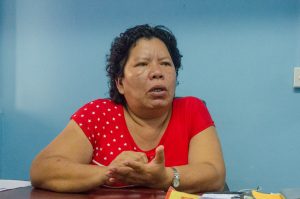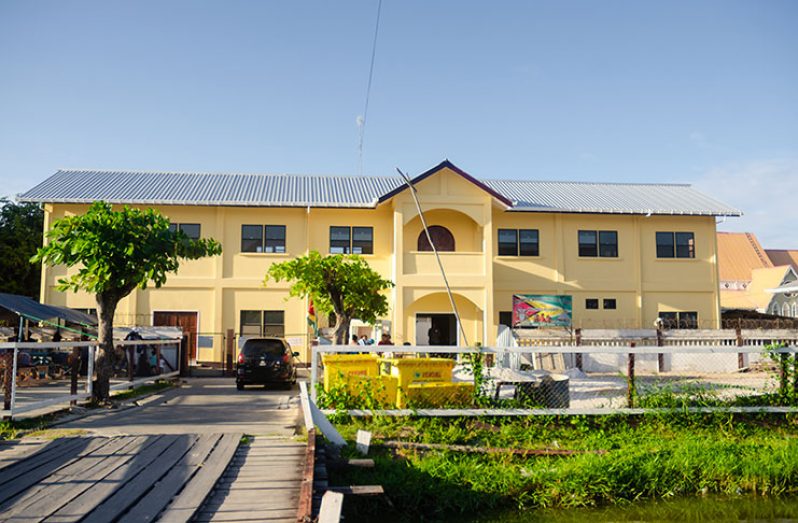– Maternity Waiting Home providing comfort mothers need
THE Indigenous Residence at Princes Street, Georgetown, continues to undergo massive transformation as the government, with support from its international partners, improves its service to the Indigenous community. In 2018, the transformation commenced with the commissioning of the rehabilitated Maternity Waiting Home. Within days, the $27M expansion project at the Indigenous Residence, which also started in 2018, will be completed.
 On Saturday, when the Guyana Chronicle visited the Indigenous Residence, the contracted team was applying the finishing touches to the multimillion-dollar building, which comprises five self-contained rooms for visiting toshaos, and offices for the medical and welfare teams.
On Saturday, when the Guyana Chronicle visited the Indigenous Residence, the contracted team was applying the finishing touches to the multimillion-dollar building, which comprises five self-contained rooms for visiting toshaos, and offices for the medical and welfare teams.
Administrator of the Indigenous Residence, Claire Emmanuel, told the Guyana Chronicle that the project is approximately 98 per cent complete. According to her, it is likely to be fully completed by April 15. The project is part of the Ministry of Indigenous Peoples’ Affairs 2018 Public Sector Investment Programme (PSIP).
The lower flat of the building was designed with offices for the nurses, as well as the welfare officers who attend to persons at the residence. Emmanuel explained that the Amerindian Hostel accommodates approximately 190 persons at a time, the majority of whom may be ill. She said having the medical and welfare offices on the lower flat of the two-storey building will prevent the temporary residents, some of whom underwent surgery, from engaging in the painful exercise of having to climb stairs to access the required personnel.
“So patients would be able to have easy access to both nurses and welfare officers, and those who underwent surgeries, wouldn’t have to climb up the stairs for their dressing,” the facilitator said.

Currently, nurses and welfare officers are housed in a section of the older building aback the new edifice. However, when they are relocated to the extended wing upon its completion, the older section will undergo further rehabilitation to extend the sleeping quarters for female occupants. Emmanuel said at any given time, there are more women in the facility, and the Ministry of Indigenous Peoples’ Affairs has committed to financing the extension to provide greater comfort to the occupants.
COMFORT
Emmanuel told this newspaper that the multimillion-dollar Maternity Waiting Home, which was built by the Ministry of Public Health through funding from the Inter-American Development Bank, has brought much-needed comfort to the high-risk pregnant mothers from the hinterland and other far-flung areas. It forms part of the government’s strategy to end maternal, prenatal and neonatal deaths throughout Guyana.
Emmanuel recalled that in the past, more than 35 pregnant women and postnatal mothers were cramped into a single room at the residence. “All of them used to be in one room…and they had to share beds, because we had limited space; and so you would have two pregnant mothers sharing a bed and there were times when they were very uncomfortable,” Emmanuel explained.
She said now the high-risk mothers are resting in comfort. Emmanuel explained that the Maternity Waiting Home is divided into two sections – one section caters for the high-risk pregnant women, while the other section caters for the mothers and their newborn. The first section has a total of 13 beds, while the latter has approximately 20 beds. The building is equipped with modern amenities such as beds and cupboards, a television set, microwave and washroom facilities. It allows pregnant women to travel to Georgetown several weeks before delivery and await the onset of labour before being transferred to the main referral hospital for safe delivery. These women come mainly from Region One (Barima-Waini), Region Seven (Cuyuni-Mazaruni), Region Eight (Potaro-Siparuni) and Region Nine (Upper Takutu-Upper Essequibo).
Emmanuel said the transformation ongoing at the Indigenous Residence is remarkable. “The indigenous people are benefitting tremendously from the improvements at the Indigenous Residence, and we are grateful for the improvements,” she said.
Vice-president and Indigenous Peoples’ Affairs Minister, Sydney Allicock, said the Maternity Waiting Home is a major plus for expecting Indigenous mothers, particularly those who are high-risk. He said the facility allows pregnant women to wait comfortably until delivery, and provides easier access to the country’s primary healthcare institution – the Georgetown Public Hospital. “So that is given as a great relief,” he told this newspaper on Saturday.




.jpg)










